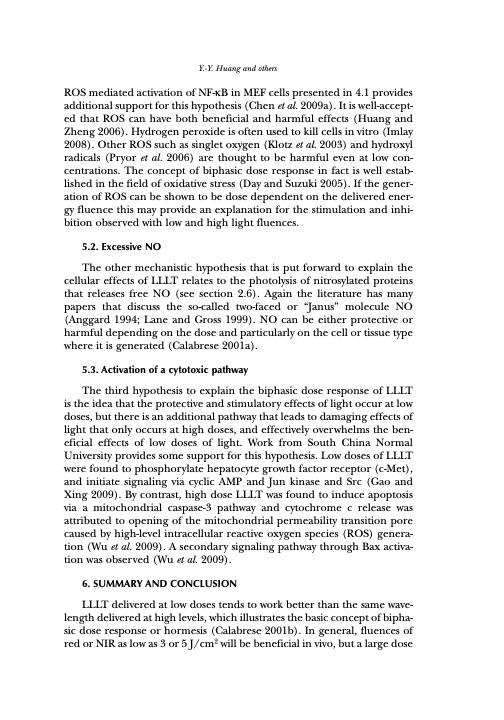
PDF Publication Title:
Text from PDF Page: 020
Y.-Y. Huang and others ROS mediated activation of NF-κB in MEF cells presented in 4.1 provides additional support for this hypothesis (Chen et al. 2009a). It is well-accept- ed that ROS can have both beneficial and harmful effects (Huang and Zheng 2006). Hydrogen peroxide is often used to kill cells in vitro (Imlay 2008). Other ROS such as singlet oxygen (Klotz et al. 2003) and hydroxyl radicals (Pryor et al. 2006) are thought to be harmful even at low con- centrations. The concept of biphasic dose response in fact is well estab- lished in the field of oxidative stress (Day and Suzuki 2005). If the gener- ation of ROS can be shown to be dose dependent on the delivered ener- gy fluence this may provide an explanation for the stimulation and inhi- bition observed with low and high light fluences. 5.2. Excessive NO The other mechanistic hypothesis that is put forward to explain the cellular effects of LLLT relates to the photolysis of nitrosylated proteins that releases free NO (see section 2.6). Again the literature has many papers that discuss the so-called two-faced or “Janus” molecule NO (Anggard 1994; Lane and Gross 1999). NO can be either protective or harmful depending on the dose and particularly on the cell or tissue type where it is generated (Calabrese 2001a). 5.3. Activation of a cytotoxic pathway The third hypothesis to explain the biphasic dose response of LLLT is the idea that the protective and stimulatory effects of light occur at low doses, but there is an additional pathway that leads to damaging effects of light that only occurs at high doses, and effectively overwhelms the ben- eficial effects of low doses of light. Work from South China Normal University provides some support for this hypothesis. Low doses of LLLT were found to phosphorylate hepatocyte growth factor receptor (c-Met), and initiate signaling via cyclic AMP and Jun kinase and Src (Gao and Xing 2009). By contrast, high dose LLLT was found to induce apoptosis via a mitochondrial caspase-3 pathway and cytochrome c release was attributed to opening of the mitochondrial permeability transition pore caused by high-level intracellular reactive oxygen species (ROS) genera- tion (Wu et al. 2009). A secondary signaling pathway through Bax activa- tion was observed (Wu et al. 2009). 6. SUMMARY AND CONCLUSION LLLT delivered at low doses tends to work better than the same wave- length delivered at high levels, which illustrates the basic concept of bipha- sic dose response or hormesis (Calabrese 2001b). In general, fluences of red or NIR as low as 3 or 5 J/cm2 will be beneficial in vivo, but a large dosePDF Image | BIPHASIC DOSE RESPONSE IN LOW LEVEL LIGHT THERAPY

PDF Search Title:
BIPHASIC DOSE RESPONSE IN LOW LEVEL LIGHT THERAPYOriginal File Name Searched:
Biphasic-Dose-Response-in-Low-Level-Light-Therapy-Harvard.pdfDIY PDF Search: Google It | Yahoo | Bing
Cruise Ship Reviews | Luxury Resort | Jet | Yacht | and Travel Tech More Info
Cruising Review Topics and Articles More Info
Software based on Filemaker for the travel industry More Info
The Burgenstock Resort: Reviews on CruisingReview website... More Info
Resort Reviews: World Class resorts... More Info
The Riffelalp Resort: Reviews on CruisingReview website... More Info
| CONTACT TEL: 608-238-6001 Email: greg@cruisingreview.com | RSS | AMP |